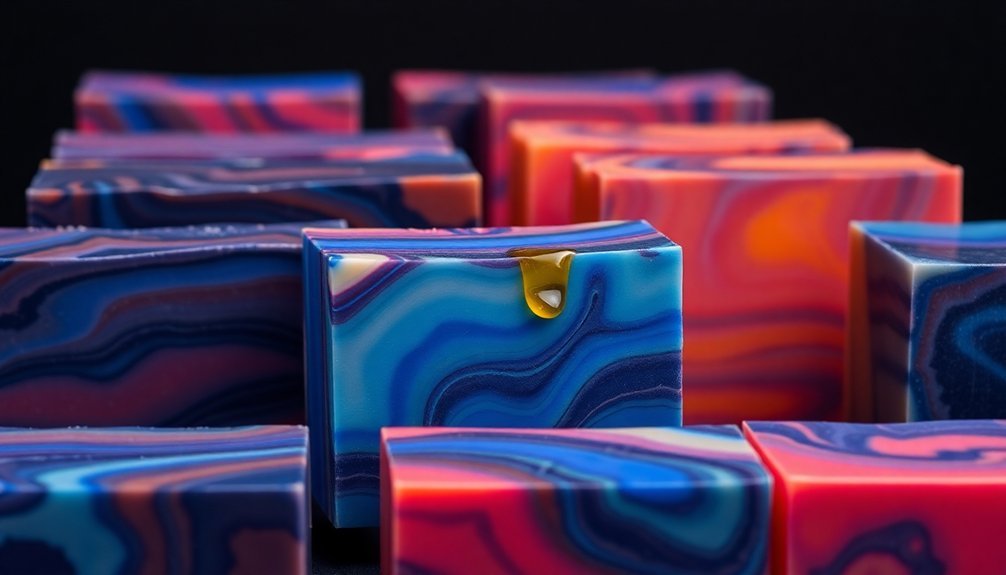To keep your soap colors bright and true, mix colorants with lightweight oils like coconut or sweet almond before adding them to your soap batter. Maintain temperatures around 100°F during mixing, and use gel phase techniques to enhance vibrancy. Store finished soaps in cool, dark places away from direct sunlight, and keep them wrapped in airtight containers. Use titanium dioxide to prevent discoloration, and document your successful techniques. Understanding these key elements will reveal even more vibrant possibilities.
Essential Colorant Selection and Preparation Methods

While creating vibrant soap colors may seem challenging, selecting and preparing your colorants correctly makes all the difference.
You'll want to start by choosing your base oils carefully – opt for lightweight oil options like coconut or sweet almond to guarantee true color representation in your final product.
For micas, mix 1 teaspoon with 1 tablespoon of lightweight oil to achieve vibrant colors without clumping.
When working with pigments, blend them with glycerin before adding to your soap batch for even dispersion.
If you're using natural colorants, you can enhance their subdued hues by combining them with pigments or using gelling techniques.
Remember that LabColors need dilution first, and you shouldn't exceed 5% of total soap weight for any colorant.
Always dilute LabColors before use and keep total colorant under 5% of soap weight for best results.
This careful preparation guarantees your colors stay bright and true throughout the curing process.
Temperature Control and Gel Phase Management

Now that you've prepared your colorants properly, mastering temperature control takes your soap's vibrancy to the next level. Keep your soap batter around 100°F during mixing to guarantee ideal color dispersion.
For enhanced color vibrancy, especially with natural colorants, you'll want to achieve the gel phase at 180°F.
You can promote a complete gel phase through insulation or the CPOP method, but watch out – excessive heat might darken your colors.
While gelling techniques can dramatically improve color retention, it's important to keep monitoring temperature throughout the process.
Make notes about your gelling techniques and their color outcomes to develop consistent results.
Through careful temperature management, you'll maintain the bright, true colors you're aiming for while avoiding unwanted color changes or fading in your finished soap.
Base Oil Combinations for Color Enhancement

Selecting the right base oil combination plays a crucial role in achieving vibrant soap colors. Your choice of base oils can either enhance or diminish the clarity of your cold process soap.
While olive oil might add unwanted yellow or green tints, lightweight oils like coconut oil and palm oil help maintain true color integrity.
For best color results in your soap making:
- Choose lighter base oils like sweet almond or coconut oil to achieve authentic hues
- Mix colorants with lightweight oils before adding them to your soap batter
- Keep superfatting percentages low to prevent color retention issues
- Consider using lard or a neutral oil blend to maximize color clarity
Storage Solutions for Long-Term Color Preservation

Once you've crafted beautifully colored soaps, proper storage becomes essential for maintaining their vibrancy.
To guarantee long-term preservation, store your soaps in a cool, dark location away from direct sunlight, which can cause colors to fade prematurely.
Choose airtight containers or wrap your soaps carefully to protect them from humidity and air exposure. If you're displaying soaps for sale, keep them covered or in shaded areas to maintain their vibrant appearance.
Avoid placing them near windows or in spaces with fluctuating temperatures, as these conditions can accelerate color degradation.
For the best results, use opaque packaging materials or tinted containers.
These protective barriers shield your soaps from harmful light exposure, helping preserve their original colors and guaranteeing they remain attractive to customers.
Natural Additives to Stabilize Color Intensity

While achieving vibrant colors in soap making is an art, natural additives can greatly enhance and stabilize your color intensity.
You'll find that titanium dioxide effectively counteracts discoloration from darker liquids, ensuring your soaps maintain their true hues. By mixing natural colorants with lightweight oils before adding them to your soap base, you'll achieve better dispersion and prevent clumping.
To maximize color stability in your soaps, follow these essential steps:
- Keep superfatting percentages lower to prevent color fading
- Mix natural colorants with lightweight oils before adding to base
- Implement gel phase techniques like CPOP to reach 180°F
- Document and test color outcomes with different natural additives
These techniques will help you maintain color vibrancy while working with natural ingredients in your soap-making process.
Frequently Asked Questions
How Do You Make Vibrant Colors in Soap?
You'll get vibrant soap colors by mixing 1 teaspoon of colorant with 1 tablespoon of light oil, using LabColors for even distribution, and insulating your soap to reach gel phase at 180°F.
Why Did My Homemade Soap Change Color?
Your soap's color change likely happened due to your fragrance oil's reaction, temperature during gel phase, or olive oil's natural tint. You'll also see changes if you didn't properly disperse your colorants.
Why Does Old Soap Turn Brown?
Your old soap turns brown because oils and fats in it oxidize when exposed to air and light. The discoloration can worsen if your fragrance oils react badly or if you've stored it in unsuitable conditions.
What Are the Orange Spots on Handmade Soap?
You'll notice orange spots on handmade soap when colorants like annatto or turmeric oxidize, or when oils rich in carotenoids react with lye. They're also caused by uneven mixing and temperature changes during curing.
In Summary
You'll find that maintaining vibrant soap colors requires careful attention throughout the entire process. Select quality colorants, control temperatures precisely, choose the right oil combinations, and store your soaps properly. Don't forget to incorporate natural stabilizers to preserve color intensity. With these techniques, you'll create beautifully colored soaps that maintain their brightness and appeal long after curing is complete.





Leave a Reply